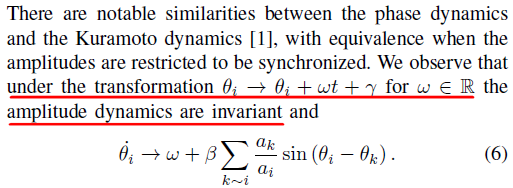I am reading the following paper: http://ieeexplore.ieee.org/document/7798534/
For the equation (5):
$$\dot{a}=(1-a_i^2)a_i-\beta\sum_{k-i}(a_k\cos(\theta_k-\theta_i)-a_i)$$
$$\dot{\theta}_i=\beta\sum_{k-i}\frac{a_k}{a_i}\sin(\theta_i-\theta_k)$$
- Both are dynamics for amplitude $a$ and phase $\theta$.
- $k-i$ means there is an edge linking the node $k$ and $i$.
- $\beta$ is just a coefficient
My question is the following:
- Why the amplitude dynamics are invariant?
and the following:
- Why it is "global phase symmetry"
- Why the equilibria are semi-stable with respect to rotation?
Thanks!


